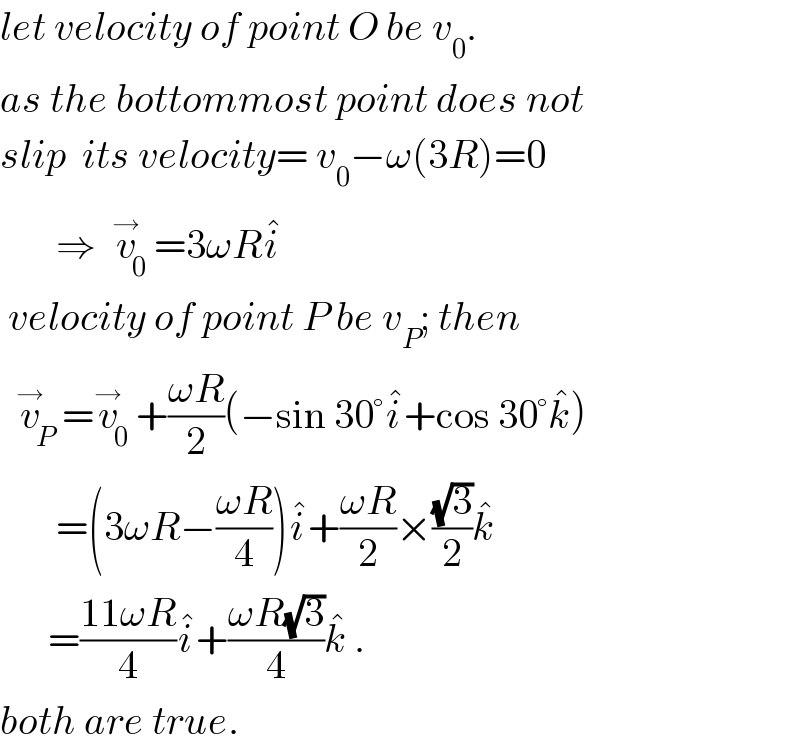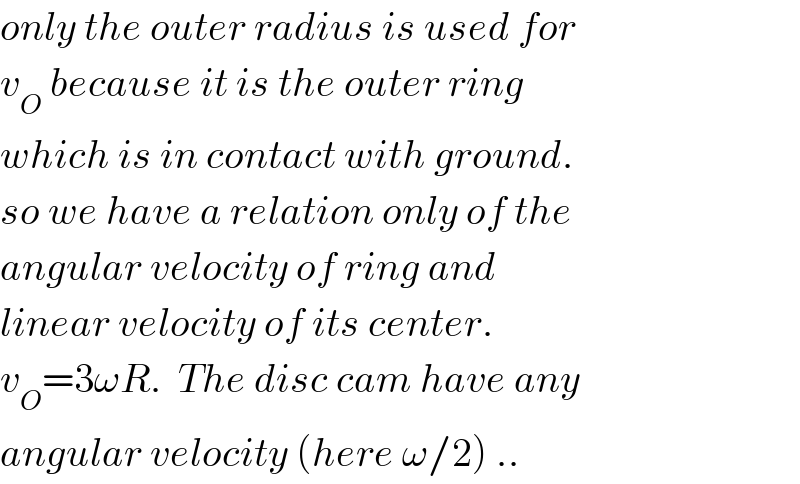
Question Number 20891 by Tinkutara last updated on 06/Sep/17

$$\mathrm{The}\:\mathrm{Figure}\:\mathrm{shows}\:\mathrm{a}\:\mathrm{system}\:\mathrm{consisting} \\ $$$$\mathrm{of}\:\left({i}\right)\:\mathrm{a}\:\mathrm{ring}\:\mathrm{of}\:\mathrm{outer}\:\mathrm{radius}\:\mathrm{3}{R}\:\mathrm{rolling} \\ $$$$\mathrm{clockwise}\:\mathrm{without}\:\mathrm{slipping}\:\mathrm{on}\:\mathrm{a} \\ $$$$\mathrm{horizontal}\:\mathrm{surface}\:\mathrm{with}\:\mathrm{angular}\:\mathrm{speed} \\ $$$$\omega\:\mathrm{and}\:\left({ii}\right)\:\mathrm{an}\:\mathrm{inner}\:\mathrm{disc}\:\mathrm{of}\:\mathrm{radius}\:\mathrm{2}{R} \\ $$$$\mathrm{rotating}\:\mathrm{anti}-\mathrm{clockwise}\:\mathrm{with}\:\mathrm{angular} \\ $$$$\mathrm{speed}\:\omega/\mathrm{2}.\:\mathrm{The}\:\mathrm{ring}\:\mathrm{and}\:\mathrm{disc}\:\mathrm{are} \\ $$$$\mathrm{separated}\:\mathrm{by}\:\mathrm{frictionless}\:\mathrm{ball}\:\mathrm{bearing}. \\ $$$$\mathrm{The}\:\mathrm{system}\:\mathrm{is}\:\mathrm{in}\:\mathrm{the}\:{x}-{z}\:\mathrm{plane}.\:\mathrm{The} \\ $$$$\mathrm{point}\:{P}\:\mathrm{on}\:\mathrm{the}\:\mathrm{inner}\:\mathrm{disc}\:\mathrm{is}\:\mathrm{at}\:\mathrm{a}\:\mathrm{distance} \\ $$$${R}\:\mathrm{from}\:\mathrm{the}\:\mathrm{origin},\:\mathrm{where}\:{OP}\:\mathrm{makes}\:\mathrm{an} \\ $$$$\mathrm{angle}\:\mathrm{30}°\:\mathrm{with}\:\mathrm{the}\:\mathrm{horizontal}.\:\mathrm{Then} \\ $$$$\mathrm{with}\:\mathrm{respect}\:\mathrm{to}\:\mathrm{the}\:\mathrm{horizontal}\:\mathrm{surface} \\ $$$$\left({a}\right)\:\mathrm{The}\:\mathrm{point}\:{O}\:\mathrm{has}\:\mathrm{a}\:\mathrm{linear}\:\mathrm{velocity} \\ $$$$\mathrm{3}{R}\omega\overset{\wedge} {{i}} \\ $$$$\left({b}\right)\:\mathrm{The}\:\mathrm{point}\:{P}\:\mathrm{has}\:\mathrm{a}\:\mathrm{linear}\:\mathrm{velocity} \\ $$$$\frac{\mathrm{11}}{\mathrm{4}}{R}\omega\overset{\wedge} {{i}}\:+\:\frac{\sqrt{\mathrm{3}}}{\mathrm{4}}{R}\omega\overset{\wedge} {{k}} \\ $$
Commented by Tinkutara last updated on 06/Sep/17

Commented by ajfour last updated on 06/Sep/17

Commented by Tinkutara last updated on 06/Sep/17

$$\mathrm{But}\:\mathrm{since}\:\mathrm{radius}\:\mathrm{at}\:{O}\:\mathrm{is}\:\mathrm{0},\:\mathrm{so}\:\mathrm{linear} \\ $$$$\mathrm{velocity}\:=\:{r}\omega\:=\:\mathrm{0}\left(\omega\right)\:=\:\mathrm{0}?\:\mathrm{Why}\:\mathrm{not}? \\ $$
Commented by ajfour last updated on 06/Sep/17

$${let}\:{velocity}\:{of}\:{point}\:{O}\:{be}\:{v}_{\mathrm{0}} . \\ $$$${as}\:{the}\:{bottommost}\:{point}\:{does}\:{not} \\ $$$${slip}\:\:{its}\:{velocity}=\:{v}_{\mathrm{0}} −\omega\left(\mathrm{3}{R}\right)=\mathrm{0} \\ $$$$\:\:\:\:\:\:\:\Rightarrow\:\:\overset{\rightarrow} {{v}}_{\mathrm{0}} =\mathrm{3}\omega{R}\hat {{i}} \\ $$$$\:{velocity}\:{of}\:{point}\:{P}\:{be}\:{v}_{{P}} ;\:{then} \\ $$$$\:\:\overset{\rightarrow} {{v}}_{{P}} =\overset{\rightarrow} {{v}}_{\mathrm{0}} +\frac{\omega{R}}{\mathrm{2}}\left(−\mathrm{sin}\:\mathrm{30}°\hat {{i}}+\mathrm{cos}\:\mathrm{30}°\hat {{k}}\right) \\ $$$$\:\:\:\:\:\:\:=\left(\mathrm{3}\omega{R}−\frac{\omega{R}}{\mathrm{4}}\right)\hat {{i}}+\frac{\omega{R}}{\mathrm{2}}×\frac{\sqrt{\mathrm{3}}}{\mathrm{2}}\hat {{k}} \\ $$$$\:\:\:\:\:\:=\frac{\mathrm{11}\omega{R}}{\mathrm{4}}\hat {{i}}+\frac{\omega{R}\sqrt{\mathrm{3}}}{\mathrm{4}}\hat {{k}}\:. \\ $$$${both}\:{are}\:{true}. \\ $$
Commented by ajfour last updated on 06/Sep/17

$${that}?{would}\:{be}\:{the}\:{case}\:{if}\:{you} \\ $$$${hang}\:{the}\:{wheel}\:{in}\:{air},\:{like}\:{a}\:{pulley}. \\ $$
Commented by ajfour last updated on 06/Sep/17

$${rolling}\:{is}\:{rotating}\:{plus}\:{sliding}.. \\ $$
Commented by Tinkutara last updated on 06/Sep/17

$$\mathrm{Then}\:\mathrm{why}\:{v}_{{O}} \:\neq\:\left(\mathrm{2}{R}\right)\left(\frac{\omega}{\mathrm{2}}\right)\:=\:{R}\omega?\:\mathrm{Why} \\ $$$$\mathrm{outer}\:\mathrm{radius}\:\mathrm{is}\:\mathrm{taken}\:\mathrm{only}? \\ $$
Commented by ajfour last updated on 06/Sep/17

$${owing}\:{to}\:{rotation}\:{the}\:{speed}\:{is} \\ $$$${zero},\:{but}\:{due}\:{to}\:{translation}\:{it}\:{is} \\ $$$$\mathrm{3}\omega{R}. \\ $$
Commented by Tinkutara last updated on 06/Sep/17

$$\mathrm{Thank}\:\mathrm{you}\:\mathrm{very}\:\mathrm{much}\:\mathrm{Sir}! \\ $$
Commented by ajfour last updated on 06/Sep/17

$${only}\:{the}\:{outer}\:{radius}\:{is}\:{used}\:{for} \\ $$$${v}_{{O}} \:{because}\:{it}\:{is}\:{the}\:{outer}\:{ring}\: \\ $$$${which}\:{is}\:{in}\:{contact}\:{with}\:{ground}. \\ $$$${so}\:{we}\:{have}\:{a}\:{relation}\:{only}\:{of}\:{the} \\ $$$${angular}\:{velocity}\:{of}\:{ring}\:{and} \\ $$$${linear}\:{velocity}\:{of}\:{its}\:{center}. \\ $$$${v}_{{O}} =\mathrm{3}\omega{R}.\:\:{The}\:{disc}\:{cam}\:{have}\:{any} \\ $$$${angular}\:{velocity}\:\left({here}\:\omega/\mathrm{2}\right)\:.. \\ $$
Commented by Tinkutara last updated on 06/Sep/17

$$\mathrm{Thanks}.\:\mathrm{Now}\:\mathrm{I}\:\mathrm{understand}. \\ $$
